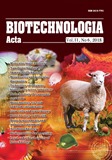ISSN 2410-776X (Online)
ISSN 2410-7751 (Print)

Biotechnologia Acta, V. 11, No 6, 2018
https://doi.org/10.15407/biotech11.06.055
Р. 55-66, Bibliography 17, English
Universal Decimal Classification: 552.57:579.6
OPTIMIZATION OF THE COAL BACTERIAL DESULFURIZATION USING MATHEMATICAL METHODS
I. A. Blaydа, N. Yu. Vasylieva, T. V. Vasylieva, L. I. Sliusarenko, O. I. Dzhambek
Odesa National Mechnykov University, Ukraine
The aim of the work was to optimize the process of bacterial desulfurization of energy coal, namely, to determine the influence of the component composition of the nutrient medium and the conditions of the process, which ensure the maximal development and activity of the aboriginal association of acidophilic chemolithotrophic bacteria and, as a consequence, the maximal index of sulfur decrease in coal in minimal time. We used the method of mathematical planning of the experiment adapted to the plan in Greek-Latin squares. The calculations in this approach are based on the analysis of variance (ANOVA). The formal planning of experiments has been carried out with four operating factors (nutrient medium components) at four levels (concentrations). The calculations were performed in Excel. The selection of operating factors and their combinations was made with the usage of unifactor ANOVA, correlation analysis and the method of principal components PCA. Researches were carried out in R 3.4.0 program and were founded on data of the preliminary evaluating experiments. Acidithiobacillus ferrooxidans Coal 17 aboriginal strain was used to obtain the most significant desulfurization effect. This strain was isolated from the investigated coal, studied and identified. The significance of the factor level for each nutrient medium component was analyzed using the Duncan’s multiple range test, the uniformity of the variances was examined with the Cochran’s test, and the significance of the factors was tested by the Fisher’s criterion. As a result, for the optimal nutrient medium the next combination of factors and their levels, which corresponds to the composition, g/dm3, was recommended: (NH4)2SO4 — 0.15; K2HPO4 — 0.50; FeSO4.7H2O — 44.0; KCl — 0.10; MgSO4·7H2O — 0.10; Ca(NO3)2 — 0.10; yeast extract — 0.025% (vol.); strain A. ferrooxidans Coal 17 (titre 1·108 CFU/ml) — 1.60% (vol.). This makes it possible to reduce the sulfur content in coal by 66.31% in a short period (seven days). This result could not be got before.
Key words: desulfurization, aboriginal association, acidophilic chemolithotrophic bacteria, plan in Greek-Latin squares, variance analysis.
© Palladin Institute of Biochemistry of National Academy of Sciences of Ukraine, 2018
References
1. Nazimko E. I. Studies on the problem of removing sulfur contained in coals. Visti Donetskoho hrnychnoho Instytutu. 2014, V. 2, P. 60–65. (In Russian).
2. Karavaiko G. I., Dubinina G. A., Kondrat’eva T. F. Lithotrophic microorganisms of the oxidative cycles of sulfur and iron. Microbiology. 2006, 75 (5), 512–545. https://doi.org/10.1134/S002626170605002X
3. Giovanni Rossi. The Microbial Desulfurization of Coal. Adv. Biochem. Eng. Biotechnol. 2014, V. 142, P. 147–167. https://doi.org/10.1007/10_2013_178
4. Blayda I., Vasyleva T. Bacterial desulfurization of Coals (review). Microbiol. Biotechnol. 2017, V. 3, P. 6–23. (In Russian). https://doi.org/10.18524/2307-4663.2017.3(39).110877
5. Fen-Fen Hong, Huan He, Jin-Yan Liu, Xiu-Xiang Tao, Lei Zheng, Yi-Dong Zhao. Comparison Analysis of Coal Biodesulfurization and Coal’s Pyrite Bioleaching with Acidithiobacillus ferrooxidans. Sci. World Jl. 2013, P. 111–120. https://doi.org/10.1155/2013/184964
6. Blaida I. A., Vasileva T. V., Sliusarenko L. I., Khitrich V. F., Ivanytsia V. A. Extraction of rare and nonferrous metals by microbial communities of the ash from burning Pavlograd’s coal. Microbiol. Biotechnol. 2012, V. 3, P. 91–101. (In Russian).
7. Levenec O. O., Hajnasova T. S., Pozolotina L. A. Modification of nutrient media for microorganisms in order to improve the physicochemical parameters of bioleaching. Gornyy informatsionno-analiticheskiy byulleten. 2016, V. 31, P. 260–271. (In Russian).
8. Grachev Ju. P., Plaksin Ju. M. Mathematical methods of experiment planning. Moskva: Nauka. 2005, 296 p. (In Russian).
9. Adler Ju. P., Markova E. V., Granovskij Ju. V. Planning an experiment when searching for optimal conditions. Moskva: Nauka. 1976, 280 p. (In Russian).
10. Zedginidze I. G. Planning an experiment to study multicomponent systems. Moskva: Nauka. 1976, 390 p. (In Russian).
11. Radchenko S. G. Analysis of experimental data based on the use of multifactorial statistical mathematical models. Matematychny mashyny y systemy. 2005, V. 3, P. 102–115. (In Russian).
12. Ahnazarova S. L., Kafarov V. V. Optimization methods in chemical technology: a textbook for chemical-tehnol. specialist. universities. (2nd ed.). Moskva: Vysshaja shkola. 1985, 327 p. (In Russian).
13. Lakin G. F. Biometrics. Moskva: Vysshaja shkola. 1990, 352 p. (In Russian).
14. Krasovskij G. I., Filaretov G. F. Experiment Planning. Minsk: Izd-vo BGU im. V. I. Lenina. 1982, 302 p. (In Russian).
15. Montgomeri D. K. Experiment planning and data analysis (translated from English). Leningrad: Sudostroenie. 1980, 380 p. (In Russian).
16. DSTU 3528-97 (GOST 8606-93, ISO 334-92). Solid mineral fuel. Determination of total sulfur. Ashka’s method. Effective from 01. 07. 1998. (In Ukrainian).
17. Lengeler J., Drevs G. I., Shlegel’ G. (Eds). Modern microbiology. Prokaryotes. V. 2. Moskva: Mir. 2005, 496 p. (In Russian).

